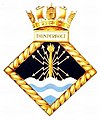 HMS Thunderbolt returning from patrol during WWII
| |
| History | |
|---|---|
| Name | HMS Thetis |
| Builder | Cammell Laird & Co Limited, Birkenhead |
| Laid down | 21 December 1936 |
| Launched | 29 June 1938 |
| Fate |
|
| Badge |  |
| Renamed | HMS Thunderbolt |
| Commissioned | 26 October 1940 |
| Fate | Sunk 14 March 1943 in the Mediterranean Sea |
| Badge |  |
| General characteristics | |
| Class and type | T-class submarine |
| Displacement |
|
| Length | 275 ft (84 m) |
| Beam | 26 ft 6 in (8.08 m) |
| Draught |
|
| Installed power |
|
| Propulsion |
|
| Speed |
|
| Range | 4,500 nmi (8,300 km; 5,200 mi) at 11 kn (20 km/h; 13 mph) |
| Test depth | 300 ft (91 m) |
| Complement | 59 |
| Armament |
|
HMS Thetis (N25) was a Group 1 T-class submarine of the Royal Navy which sank during sea trials in Liverpool Bay, England on 1 June 1939. After being salvaged and repaired, the boat was recommissioned as HMS Thunderbolt in 1940. It served during the Second World War until being lost with all hands in the Mediterranean on 14 March 1943.[1]
The Thetis accident happened after the inner hatch on a torpedo tube was opened while the outer hatch to the sea was also open. Four men successfully used the aft escape chamber to reach the surface and be rescued. A total of 99 men died as a result. The sinking led to the redesign of all torpedo tubes on British and Australian submarines. A latch, known as the "Thetis clip", was added to the inner torpedo tube door so it could be fractionally opened to check the tube was not open to the sea before being fully opened.[2]
- ^ "HMS Thunderbolt (N 25)". uboat.net. Retrieved 6 January 2007.
- ^ "Moments that shocked North Wales: The sinking of HMS Thetis in 1939". Daily Post. 17 April 2013.